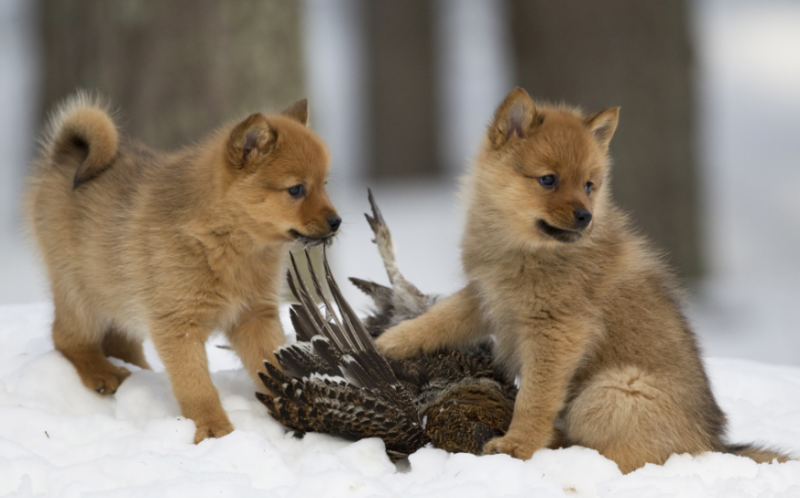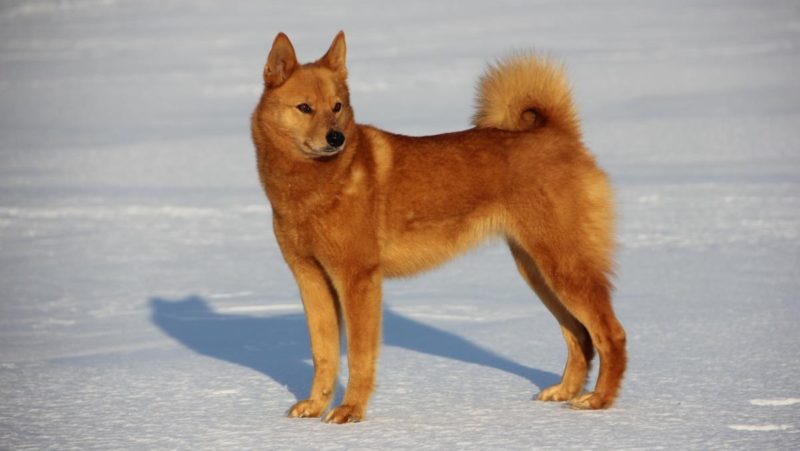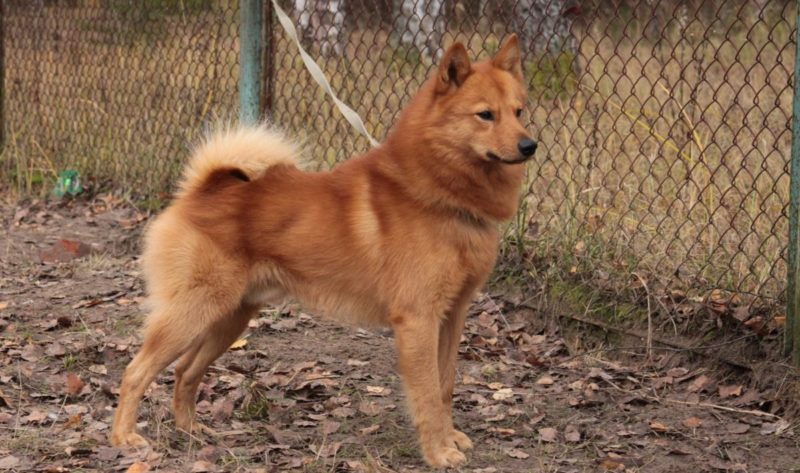Among the many varieties of hunting dogs, a bright and beautiful Finnish Spitz stands out. In addition to a noticeable appearance, he is distinguished by a livable character and unwavering loyalty to the owner. What should people know who decide to make the Finnish Spitz (Karelian-Finnish husky) their pet?
Material Content:
Description and nature of the breed
Karelian-Finnish husky is a small dog of hunting breed, which is distinguished by its bright color, furry coat and tail fervently twisted into a ringlet.
This variety of huskies is an example of understanding and faithful friends, with all sincerity attached to their master and home. The balanced character of the dog is combined with unwavering goodwill. Karelians rarely show aggression for no apparent reason.
But despite the loving nature of the carriages, these creatures have an incomparable self-esteem, which should not be neglected even by the beloved owner.
Note. An attentive owner can always determine that his pet is offended by something. Karelka will clearly make this clear by intensively unrolling the donut tail. In angry or upset animals, it becomes almost straight.
Karelian-Finnish huskies are almost ideal guards, very wary of the appearance of strangers in the territory entrusted to them.
Description of the breed:
- The height of the huskies at the withers reaches 40 - 50 cm, weight - 7 - 13 kg. These relatively small sizes help the carriages to remain mobile in any situation.At the same time, these dogs have a powerful skeleton and strong paws.
- A strong neck is crowned with a heavy square head, a wide forehead gradually passes to a cone-shaped muzzle.
- Huskies have strong teeth and the right bite.
- The triangular ears are pointed up, the nose is black or brown.
- The oval eyes are brown and slightly slanted.
- The massive chest descends to the elbows, the strong back merges with the short lumbar region.
- The tail of the doggie is fluffy, bent by a ring and thrown onto the back.
- The length of the coat is medium, in the front part of the hairs harder and shorter, in the back - longer and softer.
- The neck and shoulders of the dogs are decorated with a long-haired “collar”.
The color of Spitz is mostly red. The breed standard allows for light marks on the chest, tail and legs of the Spitz. Occasionally, dark stripes can be found in the area of the back and tail.
The history of the origin of the Karelian-Finnish husky
The first mention of Finnish spitz belonged to the French traveler Pierre la Martignar. Conquering the vastness of Finland, he described in detail the magnificent golden-red dogs that amazed him with their ideal hunting skills and good-natured disposition.
Modern breeders still can not come to a consensus on the emergence of Karelians. Some researchers are sure that the ancestors of these dogs are fossil wolf-shaped dogs that have lived next to a primitive man since the Stone Age. After years and centuries, these dogs have greatly altered, but still did not belong to any breed, being considered ordinary mongrels. This variety of dogs inhabited a small part of the Arkhangelsk region, as well as the territory of Karelia and Finland, which led to the further name of the breed. Since about the beginning of the 19th century, Finnish dog breeders have seriously started breeding smart reddish dogs.
Note. Karelian-Finnish huskies got this name in the 20s of the twentieth century. The Great Patriotic War nearly destroyed these magnificent animals. The surviving individuals were hastily exported to Finland, where they managed to save and breed the carriages.
Initially, the carriages were bred exclusively for hunting. With these fearless animals, hunters drove a hare, a squirrel, a marten, a bird. They were also used to harass large predators, in particular, the bear.
Modern huskies are appreciated by people for their excellent watchdog qualities and a noticeable exterior that makes these doggies the favorites of family members.
Puppy selection criteria
Choose small carriages should be when the last will be 2 or 3 months. It is also possible to purchase an adult animal, however, before purchasing it, you should make sure that the dog has passed the training course and has a good upbringing.
Karelian-Finnish husky babies should be purchased in specialized nurseries. If the owner needs a future hunter for the corral of game, you need to find out details regarding the working qualities of the parents of a Finnish Spitz puppy. Manufacturers must have a number of certificates and diplomas.
A small like should be folded proportionally. Her coat should be clean without dandruff and bald spots. In the selection process, you should pay attention to the most playful, contact and funny puppies. Kids should not be afraid of extraneous sounds and the appearance of strangers.
If a husky is chosen solely for serving as a pet, it is better to acquire girls. Ladies are considered calmer creatures, less inclined to leadership, compared to males.
Keeping and caring for a dog
The basic rules for caring for Finnish Spitz are as follows:
- Follow the puppy with utmost care - huskies are extremely curious. It is possible that on a walk the kids strive to taste the objects surrounding them, which can lead to various diseases.
- Care should be taken for timely vaccination of the dog.
- Spitz fur coat requires care, as long hairs tend to become tangled. For this reason, you can comb out doggies 2 to 3 times a week. Bathing the carriages as well as cutting, should not be too often, enough 1 - 2 times a year.
- Finnish Spitz grooming should be entrusted to a professional.
- Laika must have its own resting place, to which it should be accustomed from the very first minutes of living in the home. Bowls with fresh water should be placed near the bed.
- Claws of animals are sheared three times a year.
- The eyes of the carriages do not require special care. With the advent of a new day, it is enough to remove from them mucous lumps formed as a result of dust entering the dog’s eyes.
- As for the ears of the animal, they need to be inspected once a week and treated as they become dirty with napkins or lotion.
Diet and diet
Puppies from 3 to 6 months old eat four times a day, after 7 months - three times. One-year-old dogs are gradually switching to a two-time meal.
- Food to the Karelians should be served in small portions.
- The menu, if it is natural, should include chicken and beef, cottage cheese, eggs and cereals.
- Cooked cereals are diluted with broth, chopped meat / vegetables are added to them.
- Beef bones with the remains of meat on them are considered equally useful.
- Non-eaten food should be removed from the bowl a few minutes after the dog’s meal. The next serving of dog food should be reduced.
It is important. Huskies should not eat sharp chicken and fish bones, as well as raw pork.
These animals are very prone to obesity, so servings should be strictly dosed. It is forbidden to feed the pet treats from the master table.
Feeding huskies is also permissible with dry food (preferably premium). You can purchase special types of prepared food intended specifically for active and moving dogs.
There should always be a bowl of clean drinking water within the reach of the husky.
How to train and educate
Like dog training is a pretty troublesome affair. These pets, despite all their love for the owner, have a self-sufficient character and do not always listen to the opinion of the owner. In addition, these animals categorically do not take a rude attitude towards themselves, which they can seriously take offense at. Hearing annoyed notes in the owner’s voice, the dog may become stubborn and not make contact. Building relations with the Karelian-Finnish husky is as firm as possible, but not tough. Praise is best for these animals.
It is interesting. It will be useful for owners involved in raising a Karelian-Finnish husky to learn that these dogs are considered fully adult by the age of 4 years.
Until this period, animals are considered the most flexible and obedient. After 4 years, huskies may show willfulness and cease to perceive the owner as a superior. However, with proper upbringing, dogs will treat the owner as a full-fledged partner whose opinion should be taken into account.
Finnish Spitz activity
Karelian-Finnish huskies can equally successfully live both within the walls of the apartment, and in a private house. However, the smaller the area of residence, the more attention and walking will be required for these animals. The carriages must be loaded with manual labor daily.
Deprived of "work" (of course, of physical labor), a like can get bored, become apathetic, and sometimes even get sick and die. You should take a charming red pet with you for hunting or create conditions for it that mimic it. These dogs are no less active at training sites.
Characteristic breed diseases
Since the Karelian-Finnish husky breed was formed under natural conditions, these dogs at one time were subject to strict natural selection. This factor made the Finnish Spitz the owner of excellent immunity and good health.
Of the typical diseases in Karelia can develop:
- joint dysplasia;
- epilepsy (rare);
- dislocated paws.
Spitz has a lifespan of about 12 years.
Pros and cons of Karelian-Finnish husky
Of the advantages of the breed Karelian-Finnish husky, the owners note:
- Independence. These animals do not require continuous attention and can play alone.
- Coziness with children and other pets.
- Cleanliness, lack of a characteristic "dog" flavor.
- Good health, stable psyche.
Of the minuses of acquiring such a pet can be identified:
- excessive appetite;
- complexity in the process of training;
- obstinacy, wayward temperament.
The Finnish Spitz is a northern hunting dog, famous for its magnificent appearance. In addition to the exterior, the owners appreciate the excellent qualities of a guard and a hunter in these dogs. The loving and cheerful Karelian-Finnish husky is a loyal and devoted friend who adores his family and his home.





















